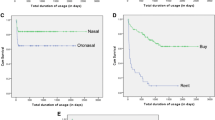Abstract
Purpose
Although continuous positive airway pressure (CPAP) is the gold standard in the treatment of obstructive sleep apnea (OSA), its effectiveness depends on the regular use. In this retrospective study, the effectiveness of CPAP with regard to the reduction of the apnea–hypopnea index was calculated based on individual adherence data extracted from a cohort of patients with OSA
Methods
The electronic database was analyzed for follow-up visits of patients receiving CPAP for OSA. The following information was extracted the charts of 750 patients: apnea–hypopnea index (AHI) at diagnosis, AHI with CPAP, duration of therapy, hours of CPAP use, and subjective hours of sleep. Eighty-two successfully treated and stable CPAP patients (AHI/Epworth Sleepiness Scale (ESS) at baseline 35.6 ± 22.1/10.5 ± 5.1) could be further evaluated.
Results
Mean AHI under CPAP was 2.4 ± 2.5 with an ESS of 6.9 ± 4.2. Subjective hours of sleep were 6.5 ± 1.1. The average treatment period was 584.6 ± 566.5 days (3,800 h of sleep). Mean hours of use was 2,712 ± 3,234 (4.69 ± 2.42 per night). This leads to the following calculated measures: hours of sleep without CPAP, 1,088; number of respiratory events with CPAP, 6508.8; number of respiratory events without CPAP, 38,732.8; total number or respiratory events, 45,241.6; average AHI, 11.91.
Conclusions
Even in an ideal group of patients, CPAP cannot eliminate respiratory events due to limited adherence. Adherence needs to be taken into account when comparing the effects of CPAP on the AHI with alternative treatment methods, especially those with 100% adherence (e.g., surgery).
Similar content being viewed by others
References
Gay P, Weaver T, Loube D, Iber C (2006) Evaluation of positive airway pressure treatment for sleep related breathing disorders in adults. Sleep 29:381–401
Giles TL, Lasserson TJ, Smith BH, White J, Wright J, Cates CJ (2006) Continuous positive airways pressure for obstructive sleep apnoea in adults. Cochrane Database Syst Rev 3: CD001106
Sanders MH, Montserrat JM, Farre R, Givelber RJ (2008) Positive pressure therapy: a perspective on evidence-based outcomes and methods of application. Proc Am Thorac Soc 5:161–172
White J, Cates C, Wright J (2002) Continuous positive airway pressure for obstructive sleep apnea. Cochrane Database Syst Rev 2:CD001106
Kushida CA, Littner MR, Hirshkowitz M, Morgenthaler TI, Alessi CA, Bailey D, Boehlecke B, Brown TM, Coleman J Jr, Friedman L, Kapen S, Kapur VK, Kramer M, Lee-Chiong T, Owens J, Pancer JP, Swick TJ, Wise MS (2006) Practice parameters for the use of continuous and bilevel positive airway pressure devices to treat adult patients with sleep-related breathing disorders. Sleep 29:375–380
Weaver TE, Maislin G, Dinges DF, Bloxham T, George CF, Greenberg H, Kader G, Mahowald M, Younger J, Pack AI (2007) Relationship between hours of CPAP use and achieving normal levels of sleepiness and daily functioning. Sleep 30:711–719
Weaver TE, Grunstein RR (2008) Adherence to continuous positive airway pressure: the challenge to effective treatment. Proc Am Thor Soc 5:173–178
Elshaug AG, Moss JR, Southcott AM, Hiller JE (2007) Redefining success in airway surgery for obstructive sleep apnea: a meta analysis and synthesis of the evidence. Sleep 30:461–467
Friedman M, Wilson M (2009) Re-redefining success in airway surgery for obstructive sleep apnea. Sleep 32:17
Ohayon MM, Carskadon MA, Guilleminault C, Vitiello MV (2004) Meta-analysis of quantitative sleep parameters from childhood to old age in healthy individuals: developing normative sleep values across the human lifespan. Sleep 27:1255–1273
Walsleben JA, Kapur VK, Newman AB, Shahar E, Bootzin RR, Rosenberg CE, O'Connor G, Nieto FJ (2004) Sleep and reported daytime sleepiness in normal subjects: the Sleep Heart Health Study. Sleep 27:293–298
Weaver TE (2006) Adherence to positive airway pressure therapy. Curr Opin Pulm Med 12:409–413
Jean Wiese H, Boethel C, Phillips B, Wilson JF, Peters J, Viggiano T (2005) CPAP compliance: video education may help! Sleep Med 6:171–174
Jiménez-Correa U, Haro R, González-Robles RO, Velázquez-Moctezuma J (2010) How is the Epworth Sleepiness Scale related with subjective sleep quality and polysomnographic features in patients with sleep-disordered breathing? Sleep Breath Jun 18. doi:10.1007/s11325-010-0372-1
Loredo JS, Ancoli-Israel S, Dimsdale JE (1999) Effect of continuous positive airway pressure vs. placebo continuous positive airway pressure on sleep quality in obstructive sleep apnea. Chest 116:1545–1549
Kribbs NB, Pack AI, Kline LR, Getsy JE, Schuett JS, Henry JN, Maislin G, Dinges DF (1993) Effects of one night without nasal CPAP treatment on sleep and sleepiness in patients with obstructive sleep apnea. Am Rev Respir Dis 147:1162–1168
Corda L, Redolfi S, Montemurro LT, La Piana GE, Bertella E, Tantucci C (2009) Short- and long-term effects of CPAP on upper airway anatomy and collapsibility in OSAH. Sleep Breath 13:187–193
Conflict of Interest
The authors declare that they have no conflict of interest.
Author information
Authors and Affiliations
Corresponding author
Rights and permissions
About this article
Cite this article
Stuck, B.A., Leitzbach, S. & Maurer, J.T. Effects of continuous positive airway pressure on apnea–hypopnea index in obstructive sleep apnea based on long-term compliance. Sleep Breath 16, 467–471 (2012). https://doi.org/10.1007/s11325-011-0527-8
Received:
Revised:
Accepted:
Published:
Issue Date:
DOI: https://doi.org/10.1007/s11325-011-0527-8




